Drs. Claudia Hernández Restrepo and colleagues study efficient material removal with different irrigation processes. See which processes achieved significantly better results!
Drs. Claudia Hernández Restrepo, Gonzalo García, Denise Alfie, Sharon R. Oyhanart, and Fernando Goldberg discuss removing organic material from simulated internal resorption cavities
Abstract
Introduction
This study aims to evaluate the efficiency of different procedures in the removal of artificial organic radiopaque material from simulated internal root resorption cavities of maxillary central incisors.
Materials and methods
Thirty extracted human maxillary central incisors were instrumented up to the working length (WL) with WaveOne® Gold Medium (WOG) (Dentsply Sirona, Ballaigues, Switzerland). Teeth were sectioned transversally at 7 mm from the anatomic apex, and cavities were drilled on the root canal of each half. Cavities were filled with organic material (corned beef, Swift, Santa Fe, Argentina) mixed with AH Plus® paste B (Dentsply Sirona) and glued back together in order to simulate an internal root resorption (IRR). All the samples were instrumented with WOG Large up to WL and divided into three groups of 10 specimens.
Group 1: Passive manual irrigation.
Group 2: Irrigation was agitated by EndoActivator® (Dentsply Tulsa Dental Specialties, Tulsa, Oklahoma).
Group 3: Irrigation was activated with XP-endo Finisher (FKG Dentaire SA, La Chaux-de-Fonds, Switzerland).
Radiographs were taken to assess the presence of residual organic radiopaque material. A score was stablished to evaluate the samples: 0, absence of organic material; 1, organic material on one wall; 2, on two walls; 3, on three walls; 4, on all of the walls. The evaluation was performed by two endodontic specialists. Data was statistically analyzed using InfoStat version by means of a non-parametric Kruskall-Wallis test with multiple comparisons. Significance level was set at p < 0.05.
Results
Group 3 showed the best results followed by Group 2 and Group 1. XP-endo Finisher and EndoActivator showed a statistically significant better performance when compared to passive manual irrigation (p < 0.05), but no differences were found between the former two.
Conclusion
XP-endo Finisher and EndoActivator showed significantly better results than passive manual irrigation in removing organic radiopaque material from simulated internal resorption cavities.
Introduction
An internal root resorption (IRR) is an inflammatory process initiated within the dental pulp that causes the resorption of dentin and possible invasion of cementum following the resorptive activity of clastic cells upon predentin and odontoblast-free dentin walls. Different etiologic factors have been proposed among which caries, dental trauma, periodontal infections, and orthodontic treatment, but it may also be rendered idiopathic.1,2 Under such circumstances, regardless whether dental pulp is still vital or necrotic at the time of diagnosis, endodontic treatment must be delivered, and its success will depend on the extent to which cleaning, disinfection, and obturation procedures can be satisfactorily performed.3
Teeth affected by IRR represent an endodontic challenge since the irregularities of the resorptive cavity present an impediment to irrigation and instrumentation as well as making it difficult for intracanal medicaments and obturation materials to reach these areas.1,2 Moreover, given the difficulty found in thoroughly eliminating bacteria and tissue debris from these cavities, strategies aimed at effectively removing them are necessary.1,2,4,5
Different irrigation techniques, intracanal medicaments, and instruments have been proposed to complete canal disinfection in such cases.1,2,4 However, a number of studies stress the difficulty in achieving this goal even in canals that display a normal anatomy.6
In teeth with IRR and vital pulp, the total removal of the organic tissue in order to stop the resorptive mechanism is very important, while in teeth with pulp necrosis, the persistence of necrotic tissue and bacteria may compromise the success of endodontic therapy.3 In order to disinfect the root resorptive cavity, some authors recommend the use of calcium hydroxide as an intracanal interappointment medicament.1,2,7
EndoActivator (Dentsply Tulsa Dental Specialties, Tulsa, Oklahoma) and XP-endo Finisher (FKG Dentaire SA, La Chaux-de-Fonds, Switzerland) are used to agitate irrigants within the root canal space in order to remove organic and inorganic remnants. This oscillating effect could improve the removal of the contents occupying the IRR cavity.
EndoActivator, is a device for sonic activation of irrigant solutions that agitates the fluid within the canal by means of an oscillating non-cutting polymer tip. This tip is available in three different sizes (15/02, 25/04, and 35/04) and can be driven at three different frequencies (2,000, 6,000, and 10,000 cycles per minute) using a button present in its handpiece.9,10
XP-endo Finisher is a non-tapered nickel-titanium instrument made of a proprietary alloy (MaxWire®; Martensite-Austenite Electropolish FleX, FKG Dentaire) with a small core size of #25 in caliber capable of changing its shape according to temperature. It displays a straight geometry at room temperature and transforms into the austenite phase when exposed to body temperature, changing its morphology, and becoming more flexible while expanding when in rotary motion.11
The aim of the present study was to evaluate in an ex vivo model the ability of different irrigation protocols (i.e., passive manual irrigation, EndoActivator, and XP-endo Finisher) to eliminate artificial organic radiopaque material from simulated IRR in human maxillary central incisors.
Materials and methods
Sample selection and standardization
Thirty extracted human maxillary central incisors with complete root formation and a single straight canal were selected by means of direct examination and the aid of preoperative radiographs taken in the bucco-lingual and mesiodistal directions. Teeth with large caries lesions, radicular fractures, and/or resorptions were excluded. To ensure sample standardization, the crowns of the selected teeth were, when needed, partially removed to achieve a final length of 21 mm using a low-speed carborundum disc under constant water cooling. Teeth were stored in 2.5% NaOCl for 48 hours and then washed under running water before experimental procedures.
Root canal instrumentation
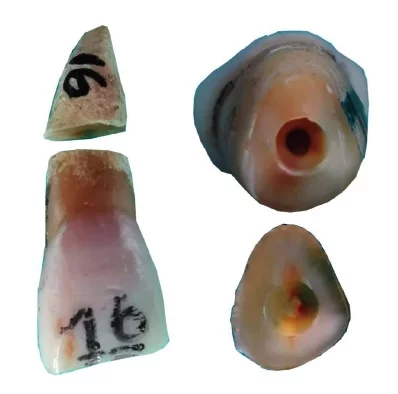
Access to the canal was established by conventional technique and patency confirmed using a size 10 K-file (Dentsply Sirona, Ballaigues, Switzerland) until its tip was visible through the main foramen. Working length for each sample was determined by subtracting 1 mm from this measurement. Root canals were prepared up to WL using WOG Medium in a reciprocating motion. For this procedure an X-Smart® Plus motor (Dentsply Sirona, Ballaigues, Switzerland) was used following the manufacturer’s instructions. During instrumentation and as a final rinse, the canals were irrigated with 3 ml of 2.5% NaOCL using a NaviTip™ No. 30 needle (Ultradent Products Inc., South Jordan, Utah).
Internal root resorption cavities preparation
To facilitate the tooth sample repositioning, a line was drawn following the long axis. Teeth were sectioned transversally at a distance of 7 mm from anatomic apex using a low-speed carborundum disc (Dentorium, New York, New York) under constant water cooling. A semicircular standardized cavity was then drilled on the root canal of each half using a round No. 5 bur with a metal stop to ensure that it would penetrate at a similar depth every time (Figure 1). Both cavities of each sample were filled with 1.80 gr of organic material (corned beef, Swift, Santa Fe, Argentina) mixed with 1.00 gr of AH Plus paste B (Dentsply Sirona), weighed using an electronic precision scale (Hometech EHA 501, China). Both halves of each tooth were glued back together using a cyanoacrylate adhesive (La Gotita, Akapol S.A., Argentina). In order to confirm that cavities had been entirely filled, digital radiographs were taken in buccolingual and mesiodistal directions. Once adhesion was established, samples were included in plastic tubes full of Reprosil® Putty (Dentsply Caulk, Milford, Delaware). After polymerization, samples were kept at 37 ºC and 100% relative humidity for 7 days.
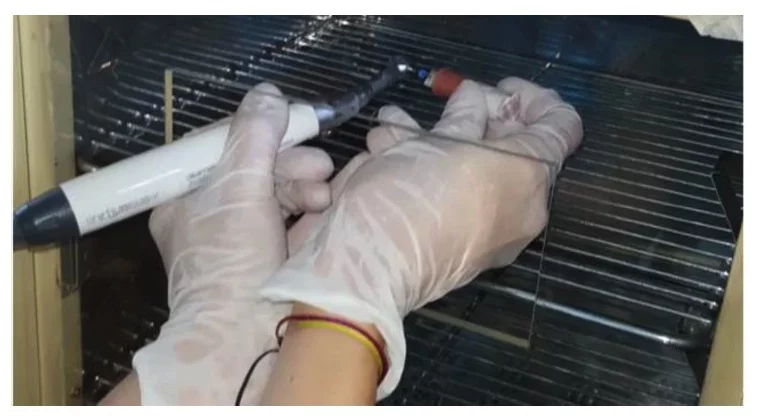
Organic radiopaque material removal protocols
Canals were then instrumented up to WL using WOG Large in a reciprocating motion according to manufacturer’s instructions. For this procedure, an X-Smart Plus motor was used. Root canals were irrigated with 2 ml of 2.5% NaOCl using and a NaviTip No. 30 needle calibrated with a silicone stop at 17 mm to guarantee the tip of the needle would exceed the depth of the resorption cavities. Specimens were then randomly separated into three groups of 10.
Group 1 (N=10): Root canals were manual passive irrigated with 6 ml of 2.5% NaOCl using the same procedure previously mentioned.
Group 2 (N=10): Root canals were irrigated with 3 ml of 2.5% NaOCl using the same procedure previously mentioned. Then EndoActivator at 10,000 cycles per minute with a polymer tip #35/04 was used to agitate the solution during 90 seconds with a pumping motion. A final rinse with 3 ml of 2.5% NaOCl ended the protocol.
Group 3 (N=10): Root canals were rinsed with 3 ml of 2.5% NaOCl, and an XP-endo Finisher file was used with an X-Smart Plus motor inserted at the WL and engine at a speed of 800 rpm and torque 1 Ncm (according to manufacturer) and operated during 90 seconds with a gentle in-and-out movement. A final rinse with 3 ml of 2.5% NaOCl ended the protocol. Each instrument was discarded after being used in three root canals. All samples were treated by the same operator. All the groups procedures were carried out at 37 °C inside an incubator (Figure 2).
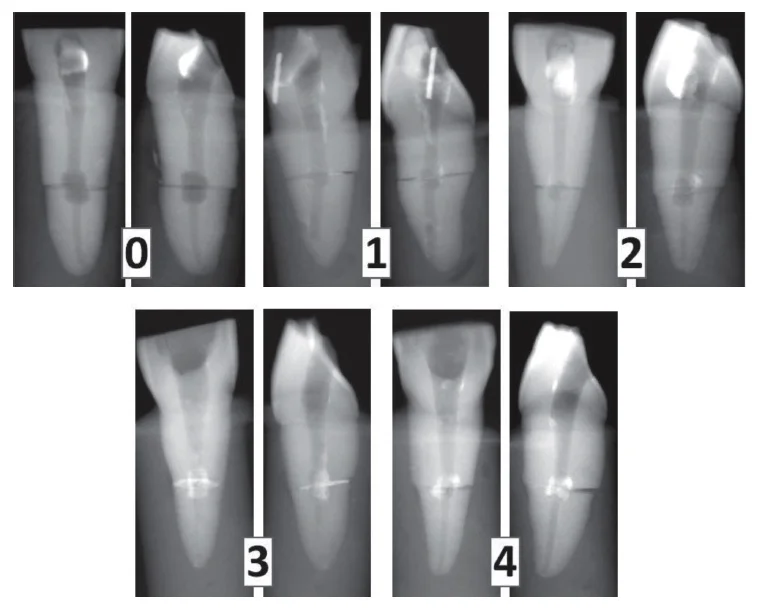
Evaluation and scoring
Mesiodistal and buccolingual radiographs were taken in order to assess the presence of residual organic radiopaque material, therefore considering all four walls of the IRR cavities. Two calibrated specialists in endodontics, who were blinded to the experimental groups, scored each sample independently according to the amount of organic radiopaque material remaining inside the IRR (Figure 3):
- Cavity free of organic radiopaque material
- Presence of organic radiopaque material on one of the walls of the cavity
- Presence of organic radiopaque material on two walls of the cavity
- Presence of organic radiopaque material on three walls of the cavity
- Presence of organic radiopaque material on all the walls of the cavity
Data was statistically analyzed using InfoStat version by means of a non-parametric Kruskall-Wallis test with multiple comparisons. Significance level was set at p < 0.05.
Results
Group 3 showed the best results followed by Group 2 and Group 1 (Table 1). EndoActivator and XP-endo Finisher showed a statistically significant better performance when compared to passive manual irrigation (p < 0.05), but no differences were found between the former two (Table 2).
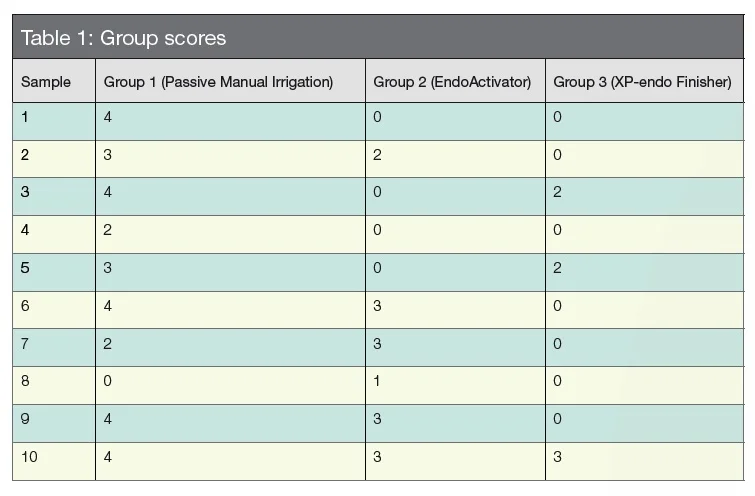
Discussion
The goal of an endodontic treatment is to clean, disinfect, and obturate the root canal system.3 In certain cases, anatomic anomalies may be present, therefore challenging clinicians and making the delivery of an adequate treatment very difficult, or even impossible.
In situations in which an IRR is present, normal root canal walls are adjacent to a cavity of irregular walls that may contain organic vital pulp or necrotic tissue and bacteria. Their removal by means of instruments, irrigation, and intracanal medicaments is of utmost importance.
In this study, a model published by Goldberg, et al.,8 was used. Simulated IRR cavities were filled with organic material in order to mimic a clinical setting. A radiopaque paste allows it radiographic observation and evaluation. Ulusoy, et al.,4 in an ex vivo study comparing different irrigation solutions activated by passive ultrasonic activation and XP-endo Finisher on the removal of organic material from simulated internal resorption cavities arrived at similar results than the present study by demonstrating the effectiveness of XP-endo Finisher.
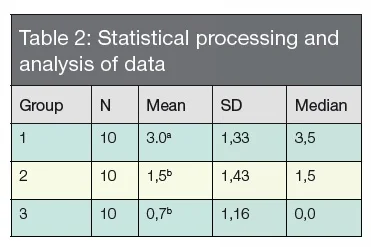
Several clinicians use calcium hydroxide as an intracanal interappointment medicament to achieve greater antibacterial effect against microorganisms surviving chemomechanical preparation. However, different authors stress the difficulty in removing calcium hydroxide from IRR cavities.5,7,10,12-16 The persistence of calcium hydroxide inside the cavity affects physical properties of endodontic sealers interfering with their adhesion to dentin walls and hindering tridimensional filling of the resorptive cavity.5,10, 12-18
Even though organic tissue present in the IRR prior to treatment differs from calcium hydroxide in its characteristics and possible dissolution mechanisms, the method used to evaluate cleanliness of resorptive cavities is rather similar. In this respect, findings by Keskin, et al.,5 match our own by showing that XP-endo Finisher performed better in removing calcium hydroxide from simulated internal resorptions of single-rooted teeth. Furthermore, Wigler, et al13 and Kfir, et al.,15 also demonstrated better results after using XP-endo Finisher to clean artificial grooves filled with calcium hydroxide.
On the other hand, Donnermeyer, et al.,16 found that sonic and passive ultrasonic irrigation were more effective in the removal of calcium hydroxide from apical grooves than XP-endo Finisher. In our study, all cleaning protocols were performed at 37 °C, simulating clinical conditions under which XP-endo Finisher instrument would expand acquiring a spoon shape over the apical few millimeters due to its MaxWire alloy. Interestingly, Göktürk, et al.,14 found that XP-endo Finisher was able to produce better results when used at a temperature of 37 °C.
Regarding the use of EndoActivator, Alturaiki et al.,10 obtained higher degrees of removal of calcium hydroxide when comparing it to ultrasonic passive irrigation and negative apical pressure. In the present study, even though EndoActivator performed better than conventional manual irrigation, it produced less satisfactory results than the XP-endo Finisher although this difference was not statistically significant.
It is also important to mention, following Topçuoglu, et al.,12 that using round burs to fabricate standardized IRR creates uniform well-characterized cavities that differ from the irregular lesions generated by the internal root resorption process. We therefore stress the need to interpret the results of these experiments with caution with regards to clinical practice.
Conclusion
EndoActivator and XP-endo Finisher showed significantly better results than passive manual irrigation in removing organic material from simulated internal resorption cavities.
Acknowledgments
Appreciation to Dr. Ricardo L. Macchi for his collaboration in the statistical evaluation.
Drs. Denise Alfie and Fernando Goldberg, who also co-authored this article on efficient material removal, worked on “A comparative study of the penetration time of different instruments and kinematics for reaching the apical limit during gutta-percha removal in endodontic retreatment.” Read their findings here.
https://endopracticeus.com/clinical-articles/a-comparative-study-of-the-penetration-time-of-different-instruments-and-kinematics-for-reaching-the-apical-limit-during-gutta-percha-removal-in-endodontic-retreatment/
- Haapasalo M, Endal U. Internal inflammatory root resorption: the unknown resorption of the tooth. Endod Topics. 2008;14(1):60-79.
- Patel S, Ricucci D, Durak C, Tay F. Internal root resorption: a review. J Endod. 2010;36(7):1107-1121.
- Schilder H. Cleaning and shaping the root canal. Dent Clin North Am. 1974;18(2):269-296.
- Ulusoy ÖI, Savur IG, Alaçam T, Çelik B. The effectiveness of various irrigation protocols on organic tissue removal from simulated internal resorption defects. Int Endod J. 2018;51(9):1030-1036.
- Keskin C, Sariyilmaz E, Sariyilmaz Ö. Efficacy of XP- endo finisher file in removing calcium hydroxide from simulated internal resorption cavity. J Endod. 2017;43(1):126-130.
- Siqueira JF Jr, Roças IN, Santos SRLD, et al. Efficacy of instrumentation techniques and irrigation regimens in reducing the bacterial population within root canals. J Endod. 2002;28(3):181-184.
- Mohammadi Z, Dummer P. Properties and application of calcium hydroxide in endodontic and dental traumatology. Int Endod J. 2011;44(8):697-730.
- Goldberg F, Massone EJ, Esmoris M, Alfie D. Comparison of different techniques for obturating experimental internal resorptive cavities. Endod Dent Traumatol. 2000;16(3):116-121.
- Jiang L-M, Verhaagen B, Versluis M, van der Sluis LWM. Evaluation of a sonic device designed to activate irrigant in the root canal. J Endod. 2010;36(8):143-146.
- Alturaiki S, Lamphon H, Edrees H, Ahlquist M. Efficacy of 3 different irrigation systems on removal of calcium hydroxide from the root canal: a scanning electron microscopic study. J Endod. 2015;41(1):97-101.
- Trope M, Debelian G. XP-3D Finisher file — the next step in restorative endodontics. Endodontic Practice US. 2015;8:22-24.
- Topçuoglu HS, Düzgün S, Ceyhanli KT, et al. Efficacy of different irrigation techniques in the removal of calcium hydroxide from simulated internal root resorption cavity. Int Endod J. 2015;48(4):309-316.
- Wigler R, Dvir R, Weisman A, Matalon S, Kfir A. Efficacy of XP-endo finisher files in the removal of calcium hydroxide paste from artificial standardized grooves in the apical third of oval root canals. Int Endod J. 2017; 50(7):700-705.
- Göktürk H, Özkoçak I, Büyükgebiz F. Effect of temperature on the ability of XP-endo Finisher to remove calcium hydroxide from root canal irregularities: ex vivo. Acta Odontol Turc. 2018;35:38-43.
- Kfir A, Blau-Venezia N, Goldberger T, Abramovitz I, Wigler R. Efficacy of self- adjusting file, XP-endo Finisher and passive ultrasonic irrigation on the removal of calcium hydroxide paste from an artificial standardized groove. Aust Endod J. 2018;44(1):26-31.
- Donnermeyer D, Wyrsch H, Bürklein S, Schäfer E. Removal of calcium hydroxide from artificial grooves in straight root canal: sonic activation using EDDY versus passive ultrasonic irrigation and XPendo Finisher. J Endod. 2019;45(3):322-326.
- Hosoya N, Kurayama H, Iino F, Arai T. Effects of calcium hydroxide on physical and sealing properties of canal sealers. Int Endod J. 2004;37(3):178-184.
- Uzunoglu-Özyürek E, Endorgan Ö, Türker SA. Effect of calcium hydroxide dressing on the dentinal tubule penetration of 2 different root canal sealers: a confocal laser scanning microscopic study. J Endod. 2018;44(6):1018-1023.
Stay Relevant With Endodontic Practice US
Join our email list for CE courses and webinars, articles and more..

